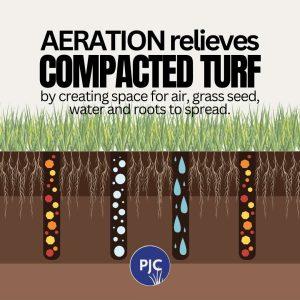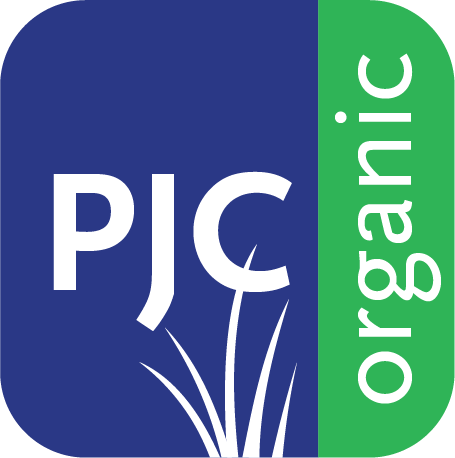Fall Mechanical Soil Aeration and Overseeding: The Winning Combo for Healthy Turf
Healthy turf starts below the surface. Soil compaction, thatch buildup, and poor air movement can limit root growth and weaken lawns and athletic fields. Address these issues through fall lawn aeration and overseeding. With cooler temperatures, less weed pressure, and active root growth, aeration in the fall sets turf up for success the following spring.

There are three main aeration methods: core aeration, solid tine aeration, and deep tine aeration. Each has its place, and knowing the benefits and drawbacks will help you choose the right one for your turf.
Pairing aeration with overseeding is one of the most effective ways to thicken lawns and improve turf health.
Core Aeration (Hollow Tine)
Core aeration removes small plugs of soil and thatch, leaving them on the surface to break down naturally.
Benefits
- Relieves soil compaction.
- Improves water, air, and fertilizer movement into the root zone.
- Helps reduce thatch (often an issue in synthetically treated turf where a vibrant soil biology is not present to break thatch down).
Drawbacks
- Leaves plugs on the surface (some homeowners find this messy).
- Requires equipment that is heavier and more labor-intensive than solid tine aeration.
Best Use
- Residential lawns with compacted soils.
- Athletic fields that see heavy use.
- Once or twice per year, ideally in the fall.
Equipment
Walk-behind aerators for small lawns; tractor-mounted units for larger properties or athletic fields.
Solid Tine Aeration
Solid tines punch holes in the soil without removing a core.
Benefits
- Fast and less disruptive than core aeration.
- Play can resume almost immediately on fields.
- Useful for light, frequent aeration.
Drawbacks
- Does not reduce thatch (see note above on core aeration).
- Repeated use on clay soils may worsen compaction.
- Can also move compaction layer further down soil profile at the depth of the solid tines.
- Less effective for overseeding
Best Use
- Sandy or loamy soils.
- Mid-season “touch-ups” on sports turf.
- Times when minimal surface disruption is important.
Equipment
Manual spike tools for small areas; tractor-mounted solid tine machines for large fields.
Deep Tine Aeration
Deep tine machines drive long tines (8–12 inches or more) into the soil.
Benefits
- Breaks up deep compaction below the normal root zone.
- Encourages roots to grow deeper.
- Improves drainage on compacted, high-traffic areas.
Drawbacks
- More expensive and slower to perform.
- Can cause significant damage to irrigation systems if the irrigation pipe placement is not accurately known.
- Generally unnecessary for typical home lawns.
Best Use
- Athletic fields, golf courses, and areas with deep compaction.
- Lawns built on poor construction fill soils.
- Fall, when turf can recover before winter.
Equipment
Tractor-mounted deep tine aerators with adjustable settings for depth and soil heave.
Overseeding After Aeration
Aeration alone helps turf breathe and grow, but aeration plus overseeding is one of the most effective combinations for building a dense, healthy stand of grass.
Why It Matters
- Holes created by aeration provide excellent seed-to-soil contact.
- Overseeding thickens thin or patchy areas, helping turf outcompete weeds.
- Establishing new grass in fall allows seedlings to root before winter and take off in spring.
Best Approach
- Mow the lawn or field short (2 ½”) before aeration.
- Aerate using core or deep tines for the best overseeding conditions.
- Immediately apply high-quality grass seed suited to your soil and sun conditions.
- Lightly drag or topdress to move seed into holes.
- Fertilize and keep soil consistently moist until seedlings establish.
Residential Lawns vs. Athletic Fields
- Residential Lawns: Core aeration once a year (or every other year) is usually enough. Solid tine tools may help in between, but deep tine is rarely needed.
- Athletic Fields: A program that combines all three methods works best. Deep tine in the fall relieves serious compaction, core aeration supports recovery during transition seasons, and solid tine can be used in-season to maintain surface porosity without disrupting play.
Key Takeaway
Fall aeration is one of the most effective steps you can take to improve soil health and turf resilience. When paired with overseeding, the results are even stronger: thicker lawns, healthier root systems, and turf that can stand up to stress. For homeowners, core aeration plus overseeding in fall is the single best practice. For athletic fields, a planned rotation of aeration methods with overseeding ensures safe, resilient, and high-performing turf year after year.
